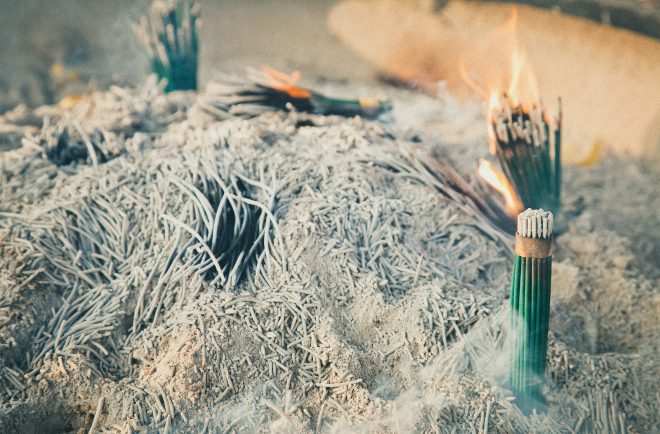
Got a djinn, demon or weird juju going on? Try smoking out your problems using this ancient western east practice, known in the west as smudging.
Seeking to clear sour, unhappy vibes out of the house and leave room for fresh, positive energies to enter, people are reviving the ancient tradition of smudging. This is burning medicinal leaves and sometimes resins, and is used in spiritual traditions around the world, in the belief that the smoke purifies the mind, the emotions, and the air. So smudge away, but keep windows open for ventilation.
Burning incense is akin to smudging, although it’s a often a form of religious offering, rather than an attempt to change our circumstances. Think of the billows of incense rising at a Catholic mass; of joss sticks held in front of Oriental tombs; of the Biblical incense burned twice daily in Solomon’s temple. Some new research even suggests that cannabis was used there. Today people use all sorts of new applications of CBD oil products. Back then, they likely just used the simple and humble plant.

Joss sticks
Incense is also offered in Hindu, and Buddhist, and Islamic ceremonies, among others. Incense offerings carry religious intention and are usually done at set times and places. Burning incense for pleasure or to anchor meditation may be done anytime, anywhere, and usually for the satisfaction of the self. African societies also have a tradition of burning herbs as medicine.
Smudging also has two faces. The First Nations tradition comes to mind first. Traditional herbs burned are tobacco, sage, cedar and sweetgrass, although sage and sweetgrass are the most often used. A booklet released by the Manitoba Indigenous Inclusion Directorate for use in Canadian schools discusses smudging at school.
They quote a community grandmother who clarifies the purposes of smudging: “We smudge to clear the air around us. We smudge to clean our minds so that we will have good thoughts of others. We smudge our eyes so that we will only see good things in others.
“We smudge our ears so that we will only listen to good things about others. We smudge our mouths so that we will only speak well of others. We smudge our whole being so that we will portray only the good part of our self through our actions.”
In the First Nation view, “Smudging allows people to stop, slow down, and become mindful and centered. This allows people to remember, connect, and be grounded in the event, task, or purpose at hand. Smudging also allows people to let go of negative feelings and thoughts. Letting go of things that inhibit a person from being balanced and focused comes from the feeling of being calm and safe while smudging. The forms of smudging will vary from nation to nation but are considered by all to be a way of cleansing oneself. Smudging is part of “the way things are done” and is part of living a good life.”
There we see that smudging is done to elevate the individual. In other cultures, a smoking bundle of herbs may be carried in a skillet from room to room to drive out spirits intent on damaging the residents, or simply to sweep residues of anger or sadness out of the house. Some like to smudge every room of a new house or apartment before moving in.
I know a woman who would burn essential oils or spray bathroom refresher all around her house after she’d quarreled with her husband. “To clear the air,” she said. I don’t know if she was following tradition or her own intuition. But it must have helped: she and her husband loved and lived together for 62 years, until he died. That woman is my mother; her husband was my father.
In Ethiopian and Yemenite tradition, a mix of resins is burned after a family feast and passed around from hand to hand for people to inhale the smoke. I have also heard that when Jewish mystics gather to study and pray, the same crumbly, blue mix is thrown on a live coal and left burning in the room.
If you want to try smudging, you can buy smudge sticks online, made of white sage leaves wrapped tightly into a thick cigar. If you grow sage in your garden, you can make your own. There are instructions online, and it’s easy to do. Remember to keep the doors and windows open when you smudge – the stagnant air needs to escape.
Given the antibacterial properties of rosemary and again, sage, for example, it’s no wonder that in “primitive” cultures small herbal bonfires are made to burn where a woman is in labor or where a sick person lives. Now, how about driving away jinns? I’ll come back to that in a future story.




One thought on “What’s Smudging, And Why Is Everyone Doing it?”
Comments are closed.